Australian Provincialism, Internationalism and the Art of Gareth Sansom 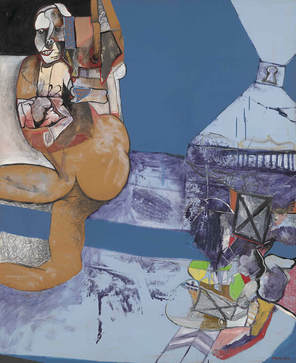 Gareth Sansom He sees himself 1964 oil, enamel paint, pencil, crayon, polyvinyl acetate, chalk and gelatin silver photograph on composition board 167.8 x 137.0 cm National Gallery of Victoria, Melbourne Presented by the National Gallery Society of Victoria, 1965 (1507-5) © Gareth Sansom/Administered by Viscopy, 2017 In 2014, Edmund Capon, the former director of the Art Gallery of New South Wales, was speaking at a conference at Beijing where he basically argued that for Australian art to receive recognition internationally it should cease being Australian and take on an international appearance. I was also speaking at the conference and argued that American art was not asked to lose its identity, or German art, French art or, for that matter, Chinese art and that great art nearly always carries the stamp of its origins. Art that lacks roots and seeks to be a global cosmopolitan product is like Esperanto, a good idea on paper, but lacking in conviction in its application. Shakespeare and Goethe translated into Esperanto will always remain a pale shadow of the original. American art was generally regarded as provincial before WWII and only in the 1950s was it seen to occupy a place on the world stage. It was a combination of quality art and a huge amount of money behind it. I would like to argue that contemporary Australian art, at its best, is world class, but we require serious money and intelligent guidance for its international advocacy. We have the depth of talent, but lack the political will, and private and public funding to make it happen. Once again I was reminded of this provincialism and internationalism debate on seeing a very impressive exhibition at the National Gallery of Victoria. Gareth Sansom is a rare and an intimidating phenomenon in Australian art – an artist who thinks deeply, is fiercely independent, is visually literate and who has mastery over an extensive range of skills. His retrospective exhibition at the National Gallery of Victoria, Gareth Sansom – Transformer is bold, provocative, exquisitely crafted – and simply brilliant. Sansom is an artist who takes no prisoners, breaks all of the rules and leaves you spellbound. Sansom was born in 1939, the same year as George Baldessin and Brett Whiteley, a generation that took pleasure in risk taking and had little reverence for the conventions of the old order. Like Baldessin and Whiteley, he too was besotted with Francis Bacon, explored the dark side of the human psyche, and is prepared to work across mediums, splicing and collaging images like the montage images in film noir that so appealed to all three artists. However, unlike his two contemporaries, Sansom has been blessed with longevity and continues to work at the peak of his powers with some of the strongest, toughest and most uncompromising pieces amongst his most recent. Sansom creates complex multi-tiered narratives in his paintings, drawings and collages. There exists a seductive temptation to decipher the story and the artist willingly provides clues from his personal biography, art historical anecdotes and other lures and traps for the viewer. Many of these clues are brought together in the excellent accompanying catalogue edited by the exhibition’s curator, Simon Maidment. In some ways, one can become engulfed in this semiotic quicksand, which is instantly gratifying in the same way as gossip may be an antidote to curiosity. We learn of the artist’s juvenile fantasies, obsessions and possible sources, but these are all largely beside the point. Knowing that the cross-dressing Barry Humphries may have inspired the artist to do the same or that he used a room at home in Sorrento to stage and photograph a scene from the Bates Motel may satisfy some of our curiosity, but it adds little to the understanding of his work. Sansom, for all of his transcultural references, is not in the final analysis a literary artist – an illustrator of verbal ideas – and for all of his reading and immersion in film and popular culture, his art is the triumph of visual intelligence. It speaks to us on a visual level that bypasses the verbal decoding. Like an alchemist, Sansom will mix a scene that can be traced back to Ingmar Bergman’s The Seventh Seal or Alfred Hitchcock’s Psycho, but he throws all of this into a creative cauldron in which image, text, difficult colours and acid colours that are painful to the eye and impossible to work with, plus a mass of other unexpected, startling imagery is brought together to shock, surprise and delight. Sansom has been doing this for sixty years and I have been viewing it for about forty years and he has never failed to shock and surprise me. At its best, the work is brilliant. From very early collages of the 1960s through to the monumental paintings of the last few years, there is an enormous consistency, emotional intensity and a generous dose of whimsy in his art. Frequently, I forget that they are also quite funny paintings. Although we may have all now become somewhat resilient to being shocked through depictions of explicit sexuality, brutal violence, graffiti and the extreme manifestations of pop art, Sansom’s work can also seduce and emotionally disarm us before visually ambushing us. This exhibition has about 130 such visual ambushes and intellectual naughty pleasures. From early show stoppers, including He sees himself (1964) and The blue masked transvestite (1964), through to much more recent pieces, such as Wittgenstein’s brush with Vorticism (2016) and Transformer (2016-17), they are all works that contain a fair amount of humour – often black humour. There is also a cringe factor at play, as if the artist has caught you in the act of enjoying his work and for this you must be humiliated. For all of the notes of anarchy and praise of the temporary and the ephemeral, throughout the exhibition you also become conscious that you are looking at complex, sophisticated and well-structured works that are built to last. 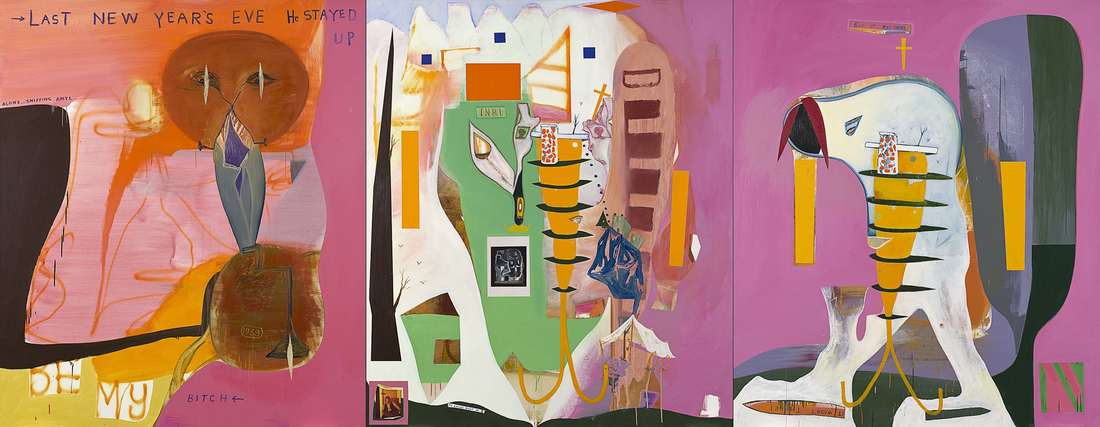 Gareth Sansom Sweeney Agonistes 2005 oil and enamel paint and collage of type C photograph on canvas (a-c) 213.0 x 549.0 cm (overall) Queensland Art Gallery, Brisbane The James C Sourris, AM, Collection. Gift of James C Sourris, AM, through the Queensland Art Gallery Foundation 2012. Donated through the Australian Government's Cultural Gifts Program (2012.472a-c) Where does this exhibition place Gareth Sansom? Much of this work – particularly that from the past twenty years – would look good in any international company. Although not shy of the fact that it is made in Australia, the imagery is definitely not made for Australian eyes only or as an export commodity that is stamped ‘Made in Australia’ for outside consumption. Just as Anselm Kiefer bears the impact of his German origins and Jean-Michel Basquiat of his emergence within the New York punk scene, Sansom is a Melbourne product of the 1960s, but has developed a unique and unmistakable artistic voice. He can comfortably take his place as an internationally significant contemporary artist. Gareth Sansom: Transformer, National Gallery of Victoria, Federation Square, Melbourne 15 September 2017 – 28 January 2018
0 Comments
Your comment will be posted after it is approved.
Leave a Reply. |
GRISHIN'S ART BLOG
Sasha Grishin AM, FAHA is the author of more than 25 books on art, including Australian Art: A History, and has served as the art critic for The Canberra Times for forty years. He is an Emeritus Professor at the Australian National University, Canberra; Guest Curator at the National Gallery of Victoria, Melbourne; and Honorary Principal Fellow, Faculty of Arts, at the University of Melbourne. Archives
September 2023
Categories
Keep up-to-date with Sasha Grishin's blog with the RSS feed.
RSS offers ease of access and ensures your privacy, as you do not need to subscribe with an email address. Click here to download a free feed reader |
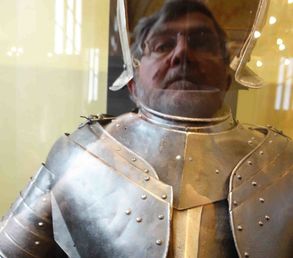
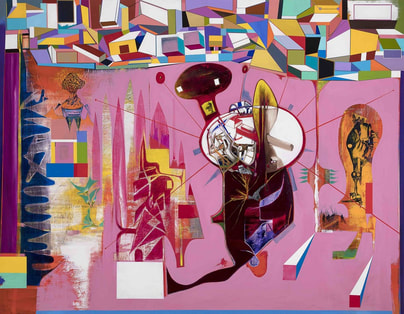
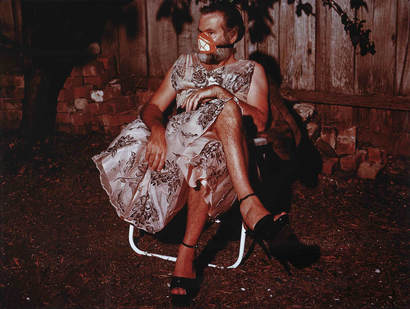
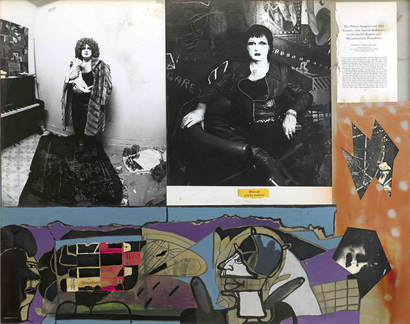
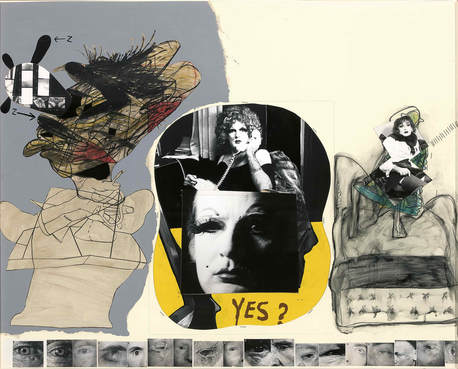
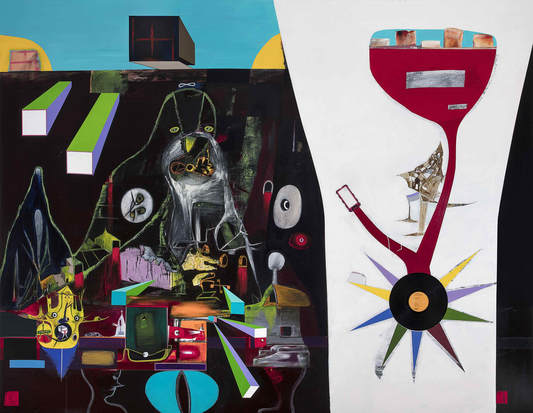
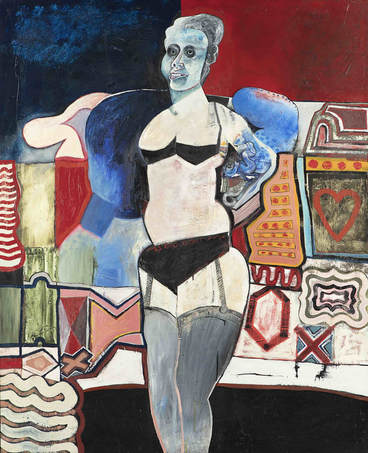
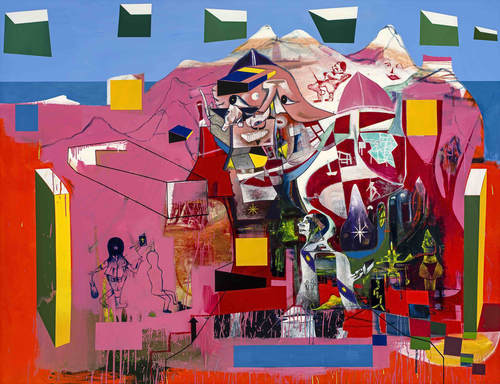
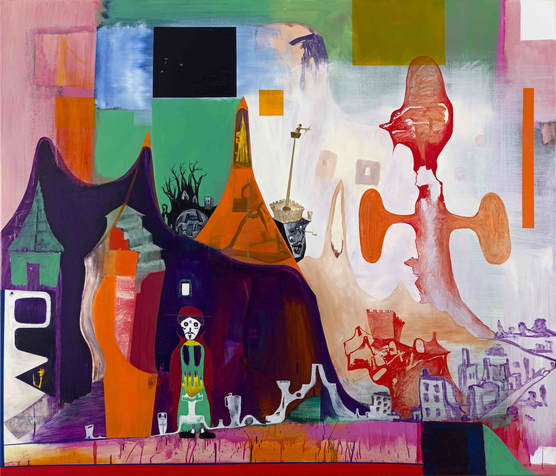
 RSS Feed
RSS Feed